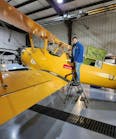With a renewed focus on developing safety enhancements to reduce the number of fatal accidents, the United States Helicopter Safety Team (www.USHST.org) has restructured its front line work groups.
The structure is closely patterned after the General Aviation Joint Steering Committee (GAJSC), which is a public-private partnership working to improve U.S. general aviation safety.
From 2016 through 2019, the USHST is focusing major attention on reducing fatal accidents within the U.S. civil helicopter community. The industry-government partnership is targeting a reduction by 2019 to 0.61 fatal accidents per 100,000 flight hours. The fatal accident rate goal for 2016 was 0.73 or lower. Preliminary figures for 2016 show an actual rate of 0.51 fatal accidents per 100,000 flight hours.
The new USHST structure places a strong emphasis on pushing forward measurable safety enhancements that will mitigate fatal helicopter accidents:
The USHST Steering Committee remains essentially the same with these members: Raj Helweg-Air Methods (industry co-chair), Jim Viola-FAA (govt co-chair), Ed DiCampli-HAI, Chris Eastlee-AMOA, Manny Figlio-Airbus, Lauren Haertlein-GAMA, Chris Lowenstein-Sikorsky, Tony Randall-Bell, Tim Tucker-Robinson, Roy Fox (advisor). Administrative coordinators are Steve Sparks of HAI and Jim Ciccone of the FAA.
The Steering Committee provides strategic guidance, management of safety plans, and direction for outreach and communications.
The Safety Analysis Team will be led by industry co-chair Mona Polson of Bell Helicopters and govt co-chair Scott Tyrrell of the FAA. They will guide three work groups organized in accident categories that have had the highest impact on fatal helicopter accidents.
- Loss of Control – Inflight Work Group, (Team Leads to be determined later this month)
- Unintended IMC Work Group
- Low Altitude Work Group
These accident categories are targeted as a result of a data-driven, consensus-based approach to analyze safety information and develop specific interventions that will mitigate the root causes of fatal accidents.
Later this month, the groups will begin developing Safety Enhancements for each targeted accident category and rank the list of Safety Enhancements in order of importance and impact to accident reduction. They also will create metrics to measure progress and periodic reports showing analysis and background data.
Possible topics for the Safety Enhancements include: 1.) issues with performance planning, 2.) weight and balance concerns, 3.) instrument proficiency, 4.) weather reporting improvements, and 5.) fatigue management.
The Outreach Team will be headed by industry co-chair Nick Mayhew of L3 Link and Tony Molinaro of the FAA. They will coordinate six focus groups organized by a targeted industry or special emphasis area.
- Personal/Private Focus Group, Lead: Dennis Pierce – Colorado HeliOps
- Air Ambulance Focus Group, Lead: Jason Quisling – Air Methods
- Commercial Ops Focus Group, Lead: Chris Young – Flatiron Solutions
- Aerial Application Focus Group, Lead: Bruce Webb – Airbus Helicopters
- Infrastructure Group, Lead: Tom Judge – LifeFlight of Maine
- Training Group , Lead: Philipp Wynands – Bristow Academy
The groups within the Outreach Team will use the prioritized Safety Enhancements to develop action plans aimed at specific mission sectors within the industry. Members of the Outreach Teams will work at gaining support for the Safety Enhancements across industry and government ranks, and will be responsible for numerous activities, including: creating educational materials, industry essays and articles; videos; speeches; publicity campaigns; conference presentations; and other safety “tools” and reports as needed.
The USHST expects to announce an initial list of safety enhancements and begin outreach to targeted sectors this summer.
More information about the USHST, its reports, safety tools, Real Safety presentations and YouTube safety videos can be obtained at its web site and on the International Helicopter Safety Team web site (www.IHST.org) and Facebook page.
